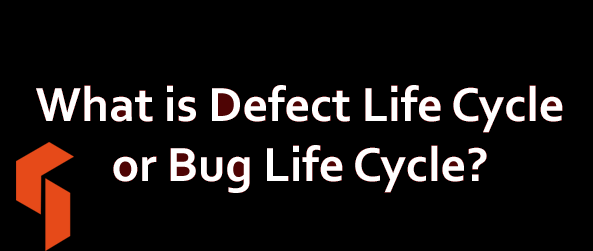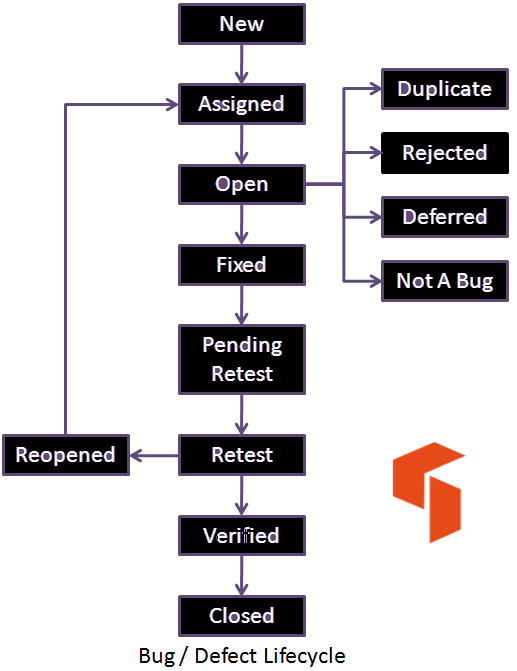Defect life cycle is a cycle which a defect goes through during its lifetime. It starts when defect is found and ends when a defect is closed, after ensuring it’s not reproduced. Defect life cycle is related to the bug found during testing.
The defect life cycle can vary from organization to organization and also from project to project based on several factors like organization policy, software development model used (like Agile, Iterative), project timelines, team structure etc. 
Some organizations / projects / managers may adopt a simpler life cycle while others may use a more extensive life cycle as described below.
Simpler implementations of the bug life cycle may not include all the states that have been shown below. This may not provide as much clarity into the defect / defect metrics, when the defects are being analyzed at a later date.
The bug has different states in the Life Cycle. The Life cycle of the bug can be shown diagrammatically as follows:
Bug or defect life cycle includes following steps or status:
- New: When a defect is logged and posted for the first time. It’s state is given as new.
- Assigned: After the tester has posted the bug, the lead of the tester approves that the bug is genuine and he assigns the bug to corresponding developer and the developer team. It’s state given as assigned.
- Open: At this state the developer has started analyzing and working on the defect fix.
- Fixed: When developer makes necessary code changes and verifies the changes then he/she can make bug status as ‘Fixed’ and the bug is passed to testing team.
- Pending retest: After fixing the defect the developer has given that particular code for retesting to the tester. Here the testing is pending on the testers end. Hence its status is pending retest.
- Retest: At this stage the tester do the retesting of the changed code which developer has given to him to check whether the defect got fixed or not.
- Verified: The tester tests the bug again after it got fixed by the developer. If the bug is not present in the software, he approves that the bug is fixed and changes the status to “verified”.
- Reopen: If the bug still exists even after the bug is fixed by the developer, the tester changes the status to “reopened”. The bug goes through the life cycle once again.
- Closed: Once the bug is fixed, it is tested by the tester. If the tester feels that the bug no longer exists in the software, he changes the status of the bug to “closed”. This state means that the bug is fixed, tested and approved.
- Duplicate: If the bug is repeated twice or the two bugs mention the same concept of the bug, then one bug status is changed to “duplicate“.
- Rejected: If the developer feels that the bug is not genuine, he rejects the bug. Then the state of the bug is changed to “rejected”.
- Deferred: The bug, changed to deferred state means the bug is expected to be fixed in next releases. The reasons for changing the bug to this state have many factors. Some of them are priority of the bug may be low, lack of time for the release or the bug may not have major effect on the software.
- Not a bug: The state given as “Not a bug” if there is no change in the functionality of the application. For an example: If customer asks for some change in the look and feel of the application like change of colour of some text then it is not a bug but just some change in the look of the application.
Other popular articles:
- What is Defect or bugs or faults in software testing?
- How to manage testing team at different levels of independence?
- Complete guide to defect management for Test / QA Managers
- What is Incident management tools?
- What is Regression testing in software?
Ajithkumar S says
Can a Rejected bug be Re-opened? If so, is that considered in the Re-open count?
Rohan says
If a developer and TL is convinced that this is a bug then it can be reopened and developer will need to fix the bug
software testing says
As a software testing student I got to learn a lot from this blog. I found your website very useful and I would like to recommend this site to everyone there . Keep sharing the knowledge .!!!
Reenu Agarwal says
In sample paper 8 question no.18 , the answer should be D ‘the bug life cycle’ is
Assigned,open, fixed, closed.
But the answer given is A Open ,Assigned ,fixed , closed.
Lavanya aradhya says
In not a bug partition :
It is mentioned as look and field, which is not correct.
It should be look and feel of application.
keerthi says
Defered, Rejection & cancellation of the defect are done by whom and why?
Parthiban R says
Above cases are done by the testing lead and all b’coz of the priority and replace the old functionality with the new one or else functionality which client want the same.
parveen says
these cases are done by the testing lead because of priority
priya says
It can be done by the Product Manager or QE Manager/Lead.
Deferred is mainly done because of plans to fix it in next release as other high priority bugs need to be fixed now.
Rejection happens if it is not a bug or it is bug which is not going to be fixed
khan says
In many sample question papers, this sequence of BLC bug life cycle is not true. Rather they start with new open assigned instead new assigned open. can you tell why is that?
vartika says
What should be the status in JIRA, if a defect is alraedy assigned to the developer and Developer needs more information on the defect.
priya says
the jira status will be still assigned, but assigned to Reporter and not the developer
and will mention that need more info
Davood says
what is the difference between rejected and not a bug?
Palash says
Rejected means the bug is not genuine and not a bug means the functionality is not getting affected in any manner and is not related to the requirements in any manner
pooja says
if same defect arises after 6 months what will be the defect status?is it reopen of same defect or is it new defect because it arises in the regression testing?
Palash says
It will be a new defect because the previous defect has been changed to closed status anfd ideally you won’t get the option to change the status to re open
Palash says
And you can create a new defect and also attach the previous defect number for the reference of the developer
shubhu kshirsagar says
what is the difference between pending retest and retest.
Divya says
If the old defect is closed then new defect as to be logged can provide the additional information in the CR by linking the old CR id.
If old CR is still in open state then child CR can be created for the new release of software version or can provide the additional information in CR details saying issue is seen in new version of release as well.
Karan says
In bug life cycle the bug is first open then assigned please correct this in the life cycle part.
Palash says
It may differ depending on the various applications for example I use HP ALM so without first assigning the defect to the developer it won’t allow me to submit the defect and once submitted the defect will change to open status
Pramila Panigrahy says
what is the difference between feedback and Deferred state of the bug
hemanth says
feedback means glance ie the corresponding tester will give the feedback to devolper abou his testing experience
deferred means the bug is opened by tester so the devolper will give the response that bug will be cleared for the next stages.so proceed for further testing